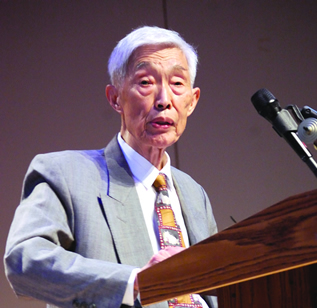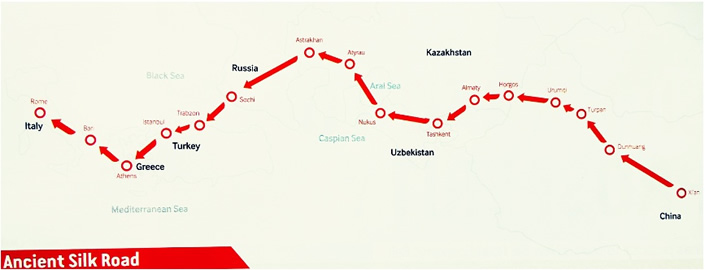 |
The Schiller Institute's
|
Bao Shixiu
A New Silk Road and A New Security Architecture for Asia
Bao Shixiu is a Professor of Military Affairs and a Senior Research Fellow at the Academy of Military Sciences, People’s Liberation Army, China.
Ladies and Gentlemen, Dear Friends,
It gives me great pleasure to come to the U.S. beautiful metropolis of New York, THE Big Apple, on the occasion of the Schiller Institute’s annual conference 2014. I think the symposium will give us the opportunity to renew friendships and explore ways to further cooperation. First of all, I wish to express my sincere thanks to Mrs. Helga Zepp-LaRouche, Founder and President of the Institute, for the warm reception and thoughtful arrangement they have made for the meeting.
An Historical Review of the Chinese Ancient Silk Road

EIRNS/Stuart Lewis..
Bao Shixiu. |
The Silk Road is a series of trade and cultural transmission routes that were central to economic and cultural interaction throughout regions of the Asian continent. It connected the West and East by linking traders, merchants, pilgrims, monks, and soldiers, from China to the Mediterranean Sea, during various periods of time. Extending 7,000 km, the Silk Road gets its name from the lucrative trade of Chinese silk which was carried out along its length, and began during the Han Dynasty (206 B.C. to 220 A.D.).
Over 2,100 years ago. Zhang Qian (c. 164-114 B.C.), the Han Dynasty envoy, expanded the trade routes to central Asia. Since then, commodities, including silk, tea, and chinaware, have been transported from Chang’an (today’s Xi’an, capital of Shaanxi Province) to Central Asia, West Asia, and even Europe via the trade route, and commodities from these destinations also found their way back to China.
Trade on the Silk Road was a significant factor in the development of the civilizations of China, the Indian Subcontinent, Persia, Europe, and Arabia. It opened long-distance political and economic interactions among the civilizations. Although silk was certainly the major item from China, many other goods were traded, and various technologies, religions, and philosophies were shared. In addition to economic trade, the Silk Road served as a means of cultural trade between the networking civilizations.
After the Tang Dynasty (618-907 A.D.), China’s political center was shifted to the northern part and its economic center was shifted to the eastern coast and southern areas. Shipping became the top choice for commodity transport and the Silk Road was later gradually abandoned.
What Is the New Silk Road Like?
The very mention of the Silk Road evokes memories of the good old times for the western region of China. Now, plans are afoot to bring back the glory days, as China proposes a modern version of the world famous trade route. In a speech at Kazakhstan’s Nazarbayev University in September 2013, Chinese President Xi Jinping proposed to establish a Silk Road Economic Belt, similar to the Silk Road of more then 2,000 years ago, to boost political and economic ties between China and the Eurasian countries. The trans-Eurasian project would target more then 3 billion people, and represent the single biggest market in the world, one with unparalleled potential.
Although the ancient Silk Road was eventually replaced by shipping routes via sea, China and the Central Asian countries have a great incentive to revive the historic link in the spirit of cooperation and mutual benefit.
Compared with 2,000 years ago, current modes of transportation between China and the Central Asian countries are far more swift and convenient. The railway from China to the Central Asian countries is the major trunk of a new Eurasian Land-Bridge. China’s expressway joins Europe’s E40 road through Central Asia. China has also opened flights to major Central Asian cities including Almaty, Tashkent, and Dushanbe.
Furthermore, China’s Xinjiang Uygur Autonomous Region features 12 land ports along the border with Kazakhstan, Kyrgyzstan, and Tajikistan.
A comprehensive transport network across China and the Central Asian countries, including railways, roads, and air travel, has now been established. The revival of the Silk Road can be expected soon.
A New Security Architecture for Asia
At a time when tensions loom over many parts of Asia, leaders from the 26-member Conference on Interaction and Confidence-Building Measures in Asia (CICA) produced a milestone declaration at a recent summit in Shanghai. The declaration highlighted their strong political will to work together in an increasingly complex international environment. The success of the summit may come as a surprise for many. But the fact that the CICA leaders were able to formulate a collective response to common challenges is evidence that Asian countries remain committed to engaging in talks to solve their problems. Moreover, they are eager to play a leading role in regional affairs.
This growing willingness to collaborate is rooted in Asian countries’ shared aspirations for peace and development. While redoubling their efforts to rev up economic growth, improve living standards, and maintain social stability, they must cement bonds with one another in pursuit of greater benefits.
Take China for instance. The rapidly emerging economy is ready to share its opportunities with neighbors, such as the New Silk Road Economic Belt and the Maritime Silk Road of the 21st Century. At the same time, it needs their cooperation in addressing problems such as terrorism, cross-border crime, and drug trafficking.
Asia has been a pivotal engine driving the global economic recovery from the 2008 financial crisis. The sustainable development of Asia, which accounts for about two-thirds of the world’s population, and one-third of its total GDP, is a blessing to humanity. In this sense, high credit should be given to the CICA.
At the recent summit, Chinese President Xi Jinping, as a conference host, expounded a new concept of security in Asia, proposing to advocate common, comprehensive, cooperative, and sustainable security.
In his keynote speech, President Xi also proposed making CICA a security dialogue and cooperation platform that covers the whole of Asia.
Xi said, “No country should seek absolute security for itself at the expense of others. We cannot just have security for one or a few countries while leaving the rest insecure. A military alliance which is targeted at a third party is not conducive to common regional security.”
As I understand it, commonness, comprehensiveness, cooperativeness, and sustainability are four pillars of the New Security Architecture for Asia; and a security for all Asian countries is its keystone.
The New Security Architecture Is Challenged by Some People
Of course, Asia is an open continent. It welcomes major global players, such as the United States. But as they get involved in the region, they must respect its realities and traditions. The past years have seen numerous cases in which their pursuit of national security resulted in the destabilization of countries in Asia.
Unfortunately, such practices have yet to be cast aside. Despite claims it would not take sides on territorial rows between China and some of its neighbors, Washington has openly supported its allies involved in the disputes, prompting many Chinese analysts to caution against what they perceive to be a return of the containment policy.
The fact is obvious in the past. When U.S. President Barack Obama came to office in 2009, he implemented a new strategic focus, that is, to rebalance the U.S. presence in the region to consolidate its dominance.
The South China Sea is a huge area of about 3.5 million square km. Chinese ownership of the islands were recorded long before Christopher Columbus first sailed to North America in 1492, and Ferdinand Magellen made his historic global voyages in the 16th Century.
But the United States is using the Philippines and Vietnam to make trouble for China by increasing tensions in this sea. It is clear that China’s legitimate drilling for oil and gas has been disrupted by Vietnamese vessels.
However, at a regional security forum, the Shangri-La Dialogue in Singapore, Chuck Hagel, the United States’ Defense Secretary, claimed that China’s actions are “destabilizing” the Asia-Pacific region. Of course his speech was refuted by experts immediately. One of observers said the finger-pointing served as an excuse for Washington to seek a closer security relationship with Asian countries, in an attempt to maintain its diminishing role amid vast cuts in its military budget.
Chinese President Xi stated that “security problems in Asia should be solved by Asians themselves, who are able to achieve regional peace and stability through cooperation.”
Yes, “security problems in Asia should be solved by Asians themselves.” Outsiders should consciously exit the game.
Thank you.

